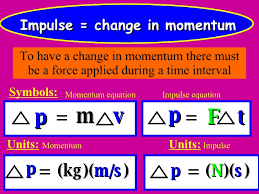Ch. 8: Momentum
Reading
College Physics, Ch. 8
AP Classroom: Unit 5 "Momentum"
AP Princeton Review: Ch. 8
Topics
Labs
College Physics, Ch. 8
AP Classroom: Unit 5 "Momentum"
AP Princeton Review: Ch. 8
Topics
- Momentum is "mass in motion"
- We will study problems involving momentum and various kinds of collisions
Labs
- Roller Coaster Design Problem class presentations
- Collision weblab
Linear momentum
Momentum is "mass x velocity" (p = mv).
Thus, it can be thought of as "mass in motion".
We use the letter "p" for momentum, because the Latin word 'petere' means "to go to", "to attack". It's where we get the words "impetuous, petulant, and impetus"
Collisions
Many homework problems from this chapter are dealing with "collisions".
Rule #1: Total momentum is conserved in all types of collisions. "Conserved" means it "doesn't change".
Rule #2: In an "elastic" collision (perfect billiard balls), both Kinetic Energy and momentum are conserved.
Rule #3: In an "inelastic" collision (billiard balls covered with Velcro), only momentum is conserved. Kinetic Energy is not.
Impulse
Impulse = Change in Momentum = Force x Elapsed Time = Mass x Change in Velocity
Impulse is a concept Newton came up with to develop his 2nd Law of Motion. We normally write the 2nd Law as "F=ma", but Newton originally expressed it using impulse.
Momentum is "mass x velocity" (p = mv).
Thus, it can be thought of as "mass in motion".
We use the letter "p" for momentum, because the Latin word 'petere' means "to go to", "to attack". It's where we get the words "impetuous, petulant, and impetus"
Collisions
Many homework problems from this chapter are dealing with "collisions".
Rule #1: Total momentum is conserved in all types of collisions. "Conserved" means it "doesn't change".
Rule #2: In an "elastic" collision (perfect billiard balls), both Kinetic Energy and momentum are conserved.
Rule #3: In an "inelastic" collision (billiard balls covered with Velcro), only momentum is conserved. Kinetic Energy is not.
Impulse
Impulse = Change in Momentum = Force x Elapsed Time = Mass x Change in Velocity
Impulse is a concept Newton came up with to develop his 2nd Law of Motion. We normally write the 2nd Law as "F=ma", but Newton originally expressed it using impulse.
Collision weblab
| 8._collision_weblab_handout_2024.docx |
Homework
Your homework is hosted in Canvas, along with the due dates.
Your homework is hosted in Canvas, along with the due dates.

